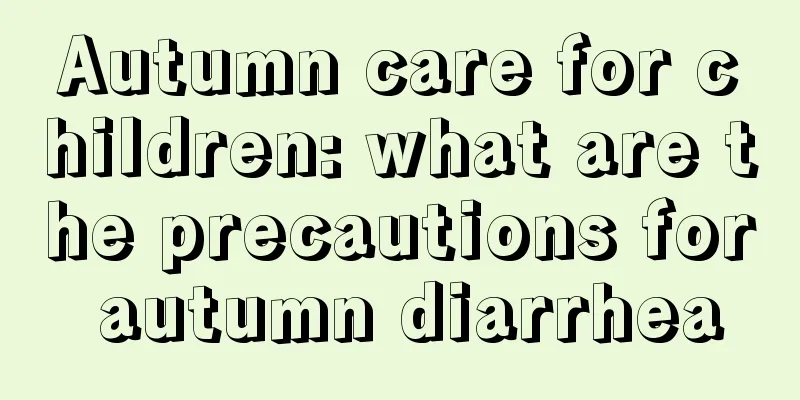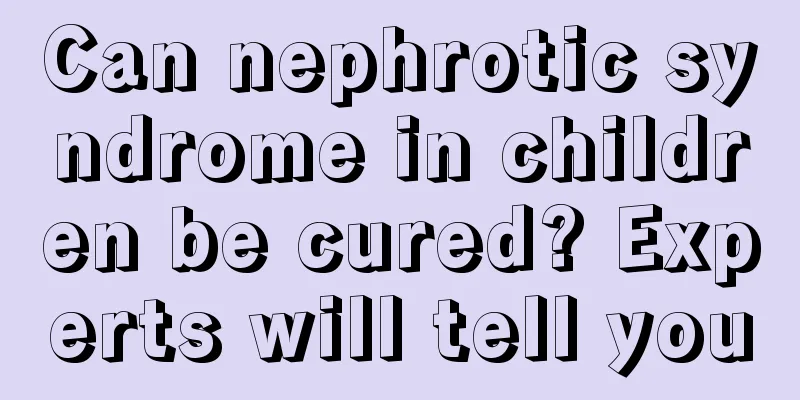Autumn care for children: what are the precautions for autumn diarrhea

|
The so-called autumn diarrhea is a gastrointestinal problem that occurs in autumn, which is especially common in the elderly and children with low immunity. For children with diarrhea, if they want to recover as soon as possible, necessary care is very necessary. For this reason, parents and friends must understand about children's autumn care and autumn diarrhea, and then through effective care, keep their children away from the trouble of diarrhea. If autumn diarrhea is not properly cared for, it can easily affect the health of children. Autumn care for children with autumn diarrhea is very important nowadays. Of course, in addition to daily dietary care, we should also pay attention to going to the hospital and seek help from doctors to keep children away from the trouble of diarrhea. Autumn diarrhea is a self-limiting disease and there is generally no specific medicine to treat it. Most children will stop having diarrhea naturally in about a week. In many poor areas with a lack of medical care and medicine, most children can recover without medication, just by oral rehydration. The problem is that when there is severe vomiting and diarrhea, if fluid replacement is not timely, dehydration will quickly occur, and the consequences will be more serious. 1. Popular Season Epidemic season: September to January of the following year is the epidemic season for autumn diarrhea, with October to December being the peak period. Susceptible groups: infants and young children aged 6 months to 3 years. Infants and young children with malnutrition, rickets, anemia and general frailty are more likely to get the disease, and the disease is more severe and lasts longer. Infants under 6 months old are less likely to suffer from autumn diarrhea because they are protected by their mothers' antibodies. Breastfed infants are even less likely to suffer from autumn diarrhea. Children over 3 years old have gradually improved and mature digestive tract functions and immune systems, and rarely suffer from autumn diarrhea. Even if they do get sick, the condition will be much milder and the course of the disease will be shorter. Adults can also be infected with autumn diarrhea, but the symptoms are similar to those of children, but the condition is mild and the course is short, and it usually recovers in 2 to 3 days. 2. The main characteristics and manifestations of autumn diarrhea The main characteristics of autumn diarrhea are: vomiting first and then diarrhea, accompanied by fever, watery or egg drop soup-like stools, and a self-limiting course. Even medication cannot significantly change the course of the disease. Symptoms: (1) The onset is acute, and the initial stage is often accompanied by cold symptoms, such as cough, nasal congestion, and runny nose. Half of the children will also have fever (common in the early stage of the disease), which is generally low-grade fever and rarely high-grade fever; (2) The frequency of bowel movements increases, to about 10 times a day, with white, yellow or green egg drop soup-like stools, a little mucus, and no fishy odor; (3) Half of the children will experience vomiting. Vomiting symptoms mostly occur in the early stages of the disease and generally do not exceed 3 days. (4) Patients with severe diarrhea may experience symptoms of dehydration, such as obvious thirst, decreased urine output, and irritability; (5) The course of the disease is self-limiting, usually 5-7 days. For those with malnutrition, rickets, or general physical weakness, the duration of diarrhea may be longer. 3. Rational use of drugs 1. Autumn diarrhea is self-limiting and will get better on its own. Taking medicine in time cannot significantly shorten the course of the disease. If the medicine is used reasonably in the early stage, it can shorten the course of the disease and alleviate the symptoms. Xinbolin+Smecta+Bifikon. Autumn diarrhea is caused by a viral infection. Although there is currently no effective drug against the virus, if Synbolin is used early, it can inhibit the replication and reproduction of the virus and reduce the number of viruses, thereby alleviating symptoms and shortening the course of the disease. 2. It is recommended to use the digestive tract mucosal protective agent montmorillonite powder (such as Smedt 1g children's package and Smecta 3g package). Smedt 1g children's package should be taken 3 times a day, one bag at a time, one bag is one gram. The 3-gram package of Smecta needs to be taken orally in 3 doses manually, and the course of treatment is 3 to 6 days. Montmorillonite powder does not enter the blood circulation and is safe to take. It is excreted from the body with the peristalsis of the large intestine a few hours after taking it. Its main ingredient, natural montmorillonite particles, have a strong fixing and inhibitory effect on viruses, bacteria in the digestive tract and the toxin gases they produce, and have a strong covering and protective ability for the gastrointestinal mucosa, repairing and improving the mucosal barrier's defense against attacking factors. It has the effect of balancing normal flora and local analgesia. Moreover, montmorillonite powder does not enter the blood circulation system, has no toxic side effects, and is very safe. For those with dysbiosis, choose microecological preparations such as Bifi-Con and Mommy Love. Supplement with large amounts of vitamin B to improve gastrointestinal function and shorten the course of the disease, such as Tongxiao and Baolikang 4. Dietary Tips for Diarrhea Fasting must not be allowed; instead, children should be encouraged to eat more, in small, frequent meals. Fasting is only necessary in one situation, that is, when the child vomits frequently and needs to go to the hospital for intravenous drip and fluid replacement. Eat mainly liquid and semi-liquid foods, such as milk, rice soup, and porridge. Do not eat soft or hard rice for the time being, and avoid allergic foods such as seafood, eggs, etc.; do not eat raw, cold, hard, fried, and fatty foods. Especially for raw and cold foods, stewed apples can stop diarrhea. Stewed apples are also rich in tannic acid protein, which has an adsorption effect and can stop diarrhea. Fried rice soup: Wash the ordinary rice, dry it, and fry it in a large pot until it turns golden brown. Add water to cook porridge and give the porridge water to the child. It also has an antidiarrheal effect. 5. Prevention of autumn diarrhea (1) Breastfeeding is best. Since breast milk is rich in immunoglobulins, it helps to enhance the gastrointestinal immunity of infants and young children. Breastfed babies are less likely to suffer from autumn diarrhea, and even if they do, the condition will be much milder. (2) Pay attention to food hygiene to prevent diseases from entering the body through the mouth. (3) Feed the baby rationally, at regular times and in fixed quantities, and add complementary foods gradually. Avoid adding several complementary foods at the same time. (4) Eat less fatty foods, eat more fresh vegetables, supplement vitamin B, and improve gastrointestinal function. (5) Strengthen physical exercise and improve physical fitness. (6) Early treatment of chronic diseases such as malnutrition, rickets, anemia, trace element deficiency, lead poisoning, etc. (7) Use medications rationally and do not abuse broad-spectrum antibiotics to avoid disruption of normal intestinal flora. Regularly take intestinal microecological regulators orally, such as Mommy Love, Bifikon, Biostime, etc., to prevent the imbalance of normal intestinal flora. (8) Get vaccinated against rotavirus. Babies aged 6 months to 3 years should be vaccinated with live rotavirus vaccine every year to prevent rotavirus diarrhea (autumn diarrhea). The vaccine is administered once a year from July to September, before the autumn diarrhea epidemic season. Autumn care for children: Autumn diarrhea directly affects the child's recovery. Some parents blindly fast their children if they have diarrhea. In fact, this method is not advisable. The most important thing is to go to the hospital for treatment and take medicine according to the doctor's advice to avoid affecting the child's health. |
<<: When should children start having their vision checked?
>>: What are the precautions for children's autumn care
Recommend
How to treat children’s thick white tongue coating?
Children's thick white tongue coating is ofte...
How to lose weight in children
Nowadays, childhood obesity has become a problem ...
Treatment of neonatal breathing with phlegm
Newborns' breathing with phlegm is one of the...
What should I do if my child has a stuffy nose and cough? A few tips for you
Mothers are very worried when their children catc...
What to do if a three-year-old child has a partial eclipse
It is very common for parents with children at ho...
The manifestations of autism, three aspects to tell you!
Autism, also known as autism in clinical practice...
What are some foods that are easy for children to digest?
Children's gastrointestinal function is relat...
How to treat green baby poop?
Your baby's poop often gives us some warnings...
How tall and heavy is a two-year-old and two-month-old baby?
After a child is born, there will be some changes...
Can children eat grasshoppers?
Grasshopper refers to cicada pupa, which is a nam...
Treatment of cerebral palsy in children
When people mention cerebral palsy in children, t...
Reasons for loose stools in three-month-old babies
If a three-month-old baby has loose stools, it ma...
One year old baby's anus is red
Because babies do not have the ability to urinate...
What are the factors that affect children’s bone development?
The bones of newborn babies are not fully develop...
What is the cause of white ringworm on the face of a 4-year-old child?
Although children do not care much about their ap...









